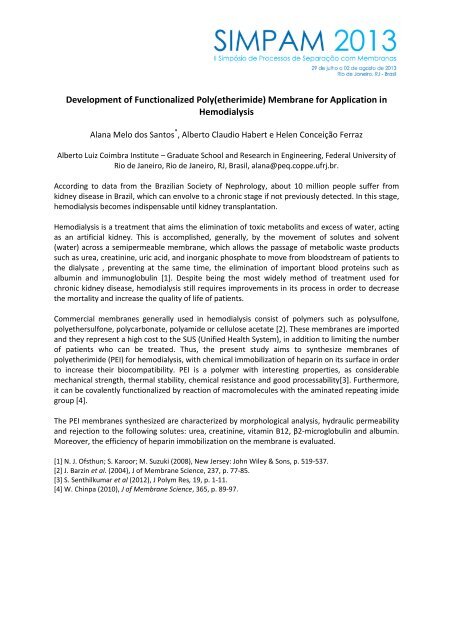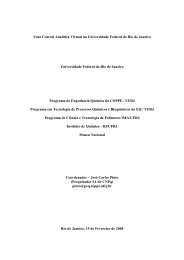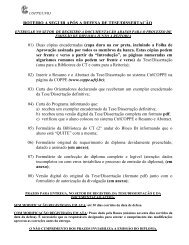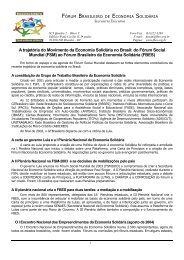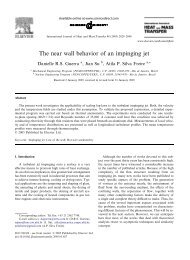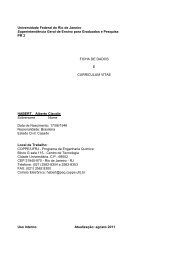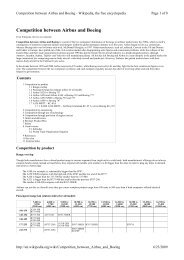- Page 1 and 2: Amirkabir Univ. Tech., IranApplicat
- Page 3 and 4: PAM/COPPE/UFRJSynthesis and Charact
- Page 7 and 8: UFSCUFSCUFSCUFSCUFSCUFSCarUFSCarUFS
- Page 9: Maximizing Hydrocarbon Liquids Reco
- Page 14 and 15: Synthesis and Gas permeation proper
- Page 17: Synthesis and characterization of F
- Page 20 and 21: [1] M. R. Kosseva (2009), Processin
- Page 22 and 23: Electrodialysis as desalting or pur
- Page 24 and 25: average permeate BOD 5 and NH 3 con
- Page 26 and 27: Evolution of Ion-Exchange Membranes
- Page 28 and 29: References[1] R. Ghalloussi, W. Gar
- Page 30 and 31: Development of Sulfonated Polysulfo
- Page 32 and 33: Selectivity of Nanofiltration Membr
- Page 34 and 35: Clarification of RED Beetroot Juice
- Page 36 and 37: Definition Of The Limiting Flux Con
- Page 38 and 39: Evaluation Of Reverse Osmosis And N
- Page 40: New Polyamide Membranes from PAMAM
- Page 43 and 44: The output variables in this study
- Page 45 and 46: In-module chemical modification and
- Page 48 and 49: Catalytic Microfiltration Membranes
- Page 52 and 53: Newly Developed Composite Hollow Fi
- Page 54: Antimicrobial polyvinyl alcohol fil
- Page 59 and 60: Polycaprolactone membranes by phase
- Page 61 and 62: [5] A. P. Harvey, M. R. Mackley, an
- Page 63 and 64: Use of Membrane Contactor to Improv
- Page 65 and 66: Recovery and concentration of efflu
- Page 67 and 68: Synthesis and Characterization of M
- Page 69 and 70: Superficial Characterization and Lo
- Page 71 and 72: Membrane Adsorber Process for Decon
- Page 74 and 75: Study of PVC Membranes Prepared Via
- Page 76 and 77: Polyvinyl Alcohol / Activated Carbo
- Page 78 and 79: Facilitated Transport of Polypropyl
- Page 80 and 81: Preparation of Chlorine-Resistant N
- Page 82 and 83: Direct Osmosis Process for Power Ge
- Page 84 and 85: Bio-Lubricant Production by Pervapo
- Page 86 and 87: Application of Ceramic Membranes fo
- Page 89 and 90: Polyurethane Membranes to Remove Su
- Page 91 and 92: Mixed Matrix Membranes for Gas Sepa
- Page 93 and 94: Oily Wastewater Treatment by Membra
- Page 95 and 96: Concentration of Copper (ppm)Percen
- Page 97 and 98: sections of membranes were observed
- Page 100 and 101:
CO 2 Separation from Natural Gas wi
- Page 102 and 103:
CO 2 Removal Systems with Membranes
- Page 104 and 105:
[6] V. Alekseev (2010), Mar. Poll.
- Page 107 and 108:
Submitted to SIMPAM 2013www.peq.cop
- Page 109 and 110:
Characterization of the Pore Size o
- Page 111 and 112:
Volume Fraction (φ)Volume Fraction
- Page 113 and 114:
Flux (kg/m 2 .hr) Flux (kg/m 2 .hr)
- Page 115 and 116:
Characterization of ionic liquid an
- Page 117 and 118:
Permeability [Barrer]7x10 46x10 45x
- Page 119 and 120:
Characteristic and Applications of
- Page 121 and 122:
Remoção de Cor (%)Remoção de Tu
- Page 123:
Removal of Trihalometanes Precursor
- Page 127 and 128:
eutilization for domestic purposes.
- Page 129 and 130:
Comparative Analysis of electrodial
- Page 132 and 133:
Intensidade (u.a.)Preparation and c
- Page 134 and 135:
THE PERFORMANCE OF A SYSTEM OF WATE
- Page 137 and 138:
Evaluating the Quality of treated w
- Page 139 and 140:
To determine the permeate flux used
- Page 141 and 142:
ConclusionsAt the present time, bas
- Page 143 and 144:
Analysis of Polymer Membranes Obtai
- Page 145:
Performance and selectivity of LLDP
- Page 148 and 149:
IntensityIntensityFigure 1. Effect
- Page 150 and 151:
Sol-gel Processing of Titania Membr
- Page 152 and 153:
All curves presented linear shape a
- Page 154 and 155:
Figure 2 - Box-Plot - Coefficient o
- Page 156 and 157:
Toxicity removal on leachate treatm
- Page 158 and 159:
Poly(vinyl alcohol) and Chitosan Bl
- Page 160 and 161:
Pressure / TorrPressure / TorrThis
- Page 162 and 163:
Vinasse Treatment by Anaerobic Memb
- Page 164 and 165:
Preparation and characterization of
- Page 166 and 167:
Microfiltration for Indigo Blue Dye
- Page 168 and 169:
PLGA Nanoparticles Containing Dexam
- Page 170 and 171:
As can be seen in Table 1, the syst
- Page 172 and 173:
231Figure 2 - Photograph of the pil
- Page 174 and 175:
AcknowledgementsThe authors acknowl
- Page 176 and 177:
Table 2 - NF feed and permeate qual
- Page 178 and 179:
COD Feed (mg/L)COD Feed (mg/L)COD P
- Page 180 and 181:
[4] RESOLUTION Nº 430, OF MAY 13,
- Page 182 and 183:
Synthesis and characterization of m
- Page 184 and 185:
Ultrafiltration/Nanofiltration for
- Page 186 and 187:
Preparation of Electrodialysis Memb
- Page 188 and 189:
[4] E. Sgreccia; M.L. Di Vona; P. K
- Page 190 and 191:
Table 1. Evaluation of solutions ob
- Page 192 and 193:
Concentration of ovine cheese whey
- Page 194 and 195:
[11] A. Chollangi; M. Hossain (2007
- Page 196 and 197:
Biofilm Formation on Laboratory Nan
- Page 198 and 199:
Removal of nitrate in aqueous efflu
- Page 200 and 201:
(aFigura 2. Difratograma das alumin
- Page 202 and 203:
AcknowledgementsReferencesWe gratef
- Page 204:
[1] COTE, P.; BUISSON, H.; PRADERIE
- Page 207 and 208:
[1] Larminie, J., Dicks, A. Fuel ce
- Page 209 and 210:
Magnetic Field Influence on Cleanin
- Page 211 and 212:
Influence Of Pretreatment On The Pe
- Page 213 and 214:
[3] Shukla, R., Cheryan, M. (2002)
- Page 215 and 216:
Separation of Mixtures of Soybean O
- Page 217 and 218:
Effect of Dense CO 2 on Polymeric C
- Page 219 and 220:
Whey VRF1,5 VRF2 VRF 2,5 VRF 3 VRF
- Page 221 and 222:
A Study of the Resistances During P
- Page 223 and 224:
Characterization of Cellulose Aceta
- Page 225 and 226:
Characterization of Cellulose Aceta
- Page 227 and 228:
Monitoring the Shelf Life of Microf
- Page 229 and 230:
Clarification of Artichoke By-produ
- Page 231 and 232:
WATER TREATMENT TO HEALTH CLINICSAn
- Page 233 and 234:
PAPER TITLE: ULTRAFILTRATION AS PRE
- Page 235 and 236:
Continuous Production of Biodiesel
- Page 237 and 238:
Performance of Liquid Membranes in
- Page 239 and 240:
Performance of Batch Pervaporation
- Page 241 and 242:
Demineralization of waste waters co
- Page 243 and 244:
Electrodialysis for food and enviro
- Page 245 and 246:
Optimizing Cobalt (II) Removal from
- Page 247 and 248:
The permeability of the material sh
- Page 249 and 250:
1D and 2D Approach for Modelling Ho
- Page 251 and 252:
Multi-stage Design for Carbon Captu
- Page 253 and 254:
Membrane Fouling Control using High
- Page 255:
AcknowledgmentsL.C. Tomé is gratef
- Page 258 and 259:
Treatment of Kraft Pulp Mill (EPO)
- Page 260 and 261:
Comparison of the Performance of Me
- Page 262 and 263:
These novel membranes are potential
- Page 264 and 265:
Polycarbonate Modified Membranes Wi
- Page 266 and 267:
Industrial Application of Membranes
- Page 268 and 269:
Production of Filtrating Membranes
- Page 270 and 271:
the high contact area provided by h
- Page 272 and 273:
of the retentate must be closely co
- Page 274 and 275:
Polymeric nanofiltration Membranes
- Page 276 and 277:
Diffusion of Monovalent Cations thr
- Page 278 and 279:
Effect of the UF-Membrane Cut-off o
- Page 280 and 281:
Saxitoxins Removal by NF270 e NF90
- Page 282:
Effect of Plasma Activation on Poly


